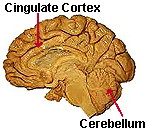Neuroscience For Kids
Colors, Colors
The famous "Stroop Effect" is named after J. Ridley Stroop who discovered this strange phenomenon in the 1930s. Here is your job: name the colors of the following words. Do NOT read the words...rather, say the color of the words. For example, if the word "BLUE" is printed in a red color, you should say "RED". Say the colors as fast as you can. It is not as easy as you might think!

 TRY
IT!
TRY
IT!
Try this Interactive Stroop Effect Experiment. The computer will keep track of the time it takes you to say the colors of the words.
Also available: print out Stroop Test Mini Cards.
Why?
 The words themselves
have a strong influence over your
ability to say the color. The interference between the different
information (what the words say and the color of the words) your brain
receives causes a problem. There are two theories that may explain the
Stroop effect:
The words themselves
have a strong influence over your
ability to say the color. The interference between the different
information (what the words say and the color of the words) your brain
receives causes a problem. There are two theories that may explain the
Stroop effect:
- Speed of Processing Theory: the interference occurs because words are read faster than colors are named.
- Selective Attention Theory: the interference occurs because naming colors requires more attention than reading words.
 I think that this puzzle would be easier for a very young child than for
older children or adults. Try this out on some small kids who know their
colors, but cannot yet read! I would imagine that the children would not
get confused by this puzzle because the words would not have any meaning
to them.
I think that this puzzle would be easier for a very young child than for
older children or adults. Try this out on some small kids who know their
colors, but cannot yet read! I would imagine that the children would not
get confused by this puzzle because the words would not have any meaning
to them.
My scores: Test #1 = 10.1 seconds; Test #2 = 22.4 seconds
It took me more than TWICE the amount of time to read the
"confusing" words.
 There is some
evidence that the anterior cingulate area is active in people during
the Stroop effect.
There is some
evidence that the anterior cingulate area is active in people during
the Stroop effect.
More experiments to try:
- Turn the words upside down or rotate them 90 degrees.
- Turn the words "inside out."
- Use non-color words such as "dog" or "house."
- Use nonsense words such as "kiw" or "thoz."
- Compare long words to short words.
- Use emotional words such as "sad" or "happy" or "depressed" or "angry."
- Color only half of the word or color only the first and last letter of each word.
The original reference to the Stroop paper is: Stroop, J.R. Studies of interference in serial verbal reactions. J. Exp. Psychol., 18:643-662, 1935. You can even read this complete 1935 paper on the web!
 If you would like to use the
Stroop Effect as an experiment in class, here is a lesson ready to go.
If you would like to use the
Stroop Effect as an experiment in class, here is a lesson ready to go.
Other web resources on the Stroop effect:
- Interference - from the American Psychological Association
- Stroop Effect - from NOVA
TRY IT! |
New Stroop TestsHere are three new variations of the Stroop Effect that you may not have seen.
Are these new tests easier or harder than the original colored word Stroop Effect? Why? |
Did you know? | Dr. Stroop left the laboratory not long after he published his studies on his "effect" and joined the faculty at David Lipscomb College, a small Christian college in Nashville, TN. He died in 1973 at the age of 76. Read more about "Brother Stroop" (that's what his students called him) in Science News, Vol. 141, pages 312-316, 1992. Also, read about the donation of Stroop's original thesis to Vanderbilt University. |
Copyright © 1996-2023, Eric H. Chudler All Rights Reserved.
